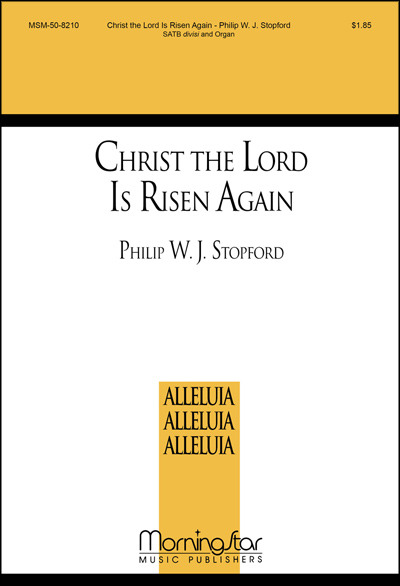- |
User Links
Christ the Lord is risen again!

Christ the Lord is risen again! Christ has broken every chain!
Author: Michael Weisse (1531); Translator: Catherine Winkworth (1858)Published in 257 hymnals
Printable scores: PDF, MusicXMLAudio files: MIDI
Representative Text
1 Christ the Lord is ris'n again;
Christ has broken death's strong chain.
Hark, the angels shout for joy,
singing evermore on high:
Hallelujah!
2 He who gave for us his life,
who for us endured the strife,
is our Paschal Lamb today.
We too sing for joy and say:
Hallelujah!
3 He who bore all pain and loss
comfortless upon the cross
lives in glory now on high,
pleads for us, and hears our cry:
Hallelujah!
4 He whose path no records tell
has descended into hell;
he the strong man armed has bound
and in highest heav'n is crowned.
Hallelujah!
5 He who slumbered in the grave
is exalted now to save;
now through Christendom it rings
that the Lamb is King of kings.
Hallelujah!
6 Now he bids us tell abroad
how the lost may be restored,
how the penitent forgiv'n,
how we too may enter heav'n,
Hallelujah!
Source: Christian Worship: Hymnal #459
Author: Michael Weisse
Michael Weiss was born at Neisse, in Silesia. He was a pastor among the Bohemian Brethren, and a contemporary with Luther. His hymns have received commendation. He died in 1540. --Annotations of the Hymnal, Charles Hutchins, M.A. 1872.… Go to person page >Translator: Catherine Winkworth
 Catherine Winkworth (b. Holborn, London, England, 1827; d. Monnetier, Savoy, France, 1878) is well known for her English translations of German hymns; her translations were polished and yet remained close to the original. Educated initially by her mother, she lived with relatives in Dresden, Germany, in 1845, where she acquired her knowledge of German and interest in German hymnody. After residing near Manchester until 1862, she moved to Clifton, near Bristol. A pioneer in promoting women's rights, Winkworth put much of her energy into the encouragement of higher education for women. She translated a large number of German hymn texts from hymnals owned by a friend, Baron Bunsen. Though often altered, these translations continue to be used i… Go to person page >
Catherine Winkworth (b. Holborn, London, England, 1827; d. Monnetier, Savoy, France, 1878) is well known for her English translations of German hymns; her translations were polished and yet remained close to the original. Educated initially by her mother, she lived with relatives in Dresden, Germany, in 1845, where she acquired her knowledge of German and interest in German hymnody. After residing near Manchester until 1862, she moved to Clifton, near Bristol. A pioneer in promoting women's rights, Winkworth put much of her energy into the encouragement of higher education for women. She translated a large number of German hymn texts from hymnals owned by a friend, Baron Bunsen. Though often altered, these translations continue to be used i… Go to person page >Text Information
Related Texts
| First Line: | Christ the Lord is risen again! Christ has broken every chain! |
| Title: | Christ the Lord is risen again! |
| German Title: | Christus ist erstanden |
| Author: | Michael Weisse (1531) |
| Translator: | Catherine Winkworth (1858) |
| Meter: | 7.7.7.7.4 |
| Language: | English |
| Refrain First Line: | Alleluia, alleluia |
| Copyright: | Public Domain |
Notes
Scripture References:
st. 2 = Rom. 8:34, Heb. 7:25
st. 4 = John 3:5
As a basis for his text "Christus ist erstanden," Michael Weisse (b. Neisse, Silesia, Poland, c. 1480; d. Landskron, Bohemia, Czechoslovakia, 1534) turned to the same earlier sources that Martin Luther had turned to just a few years earlier (PHH 398). Weisse also reworked the older chorale "Christ ist erstanden," at that time a popular "leise"–a song that included a "Kyrie eleison" refrain shortened to "kirleis" or "leis." The original "Christ is erstanden" was developed from the Latin sequence “Victimae Paschali laudes” (c. 1100). Weisse's chorale was published in the first German-language Bohemian hymnal Ein Neugesängbuchlein (1531), which he edited. The hymnal contained 155 hymns, with some original texts written by Weisse and others translated by him from Bohemian. Many of Weisse's hymn texts also found their way into later German hymnals.
Weisse was a monk in Breslau when he came in contact with the writings of Martin Luther. After leaving the Roman Catholic Church, he joined the Bohemian Brethren, spiritual descendants of John Hus, who were later called Moravians. A leader among the Bohemian Brethren, Weisse established a number of their German-speaking communities and was sent to consult with Luther on issues of theology.
Catherine Winkworth (PHH 194) translated Weisse's text, which was published in her Lyra Germanica (1858). Originally entitled "Song of Triumph," the translation began with the words, "Christ the Lord is risen again." The Psalter Hymnal includes Winkworth's stanzas 1, 3, 7, and 6 (in that order).
Stanzas 1 and 2 focus on the Christ, who suffered death on the cross but who is now exalted in glory as our mediator. Stanza 3 is a prayer especially suited for celebration of Lord's Supper. Stanza 4 encourages us to preach the good news to extend Christ's kingdom. Each stanza concludes with an "alleluia." The final refrain rings in even more “alleluias” and includes the cosmic testimony “the Lamb is King of kings!”
Liturgical Use:
Easter; Ascension; Lord's Supper.
Tune
WÜRTEMBURG (Rosenmüller)Also known as: NASSAU STRAF MICH NICHT
CHRIST IST ERSTANDEN
CHRIST IST ERSTANDEN is derived from the twelfth-century chant melody for "Victimae Paschali laudes" (which also produced CHRIST LAG IN TODESBANDEN, 398). The tune was first published in Joseph Klug's (PHH 126) Geistliche Lieder (1533). This ancient tune, originally in Dorian mode, consists of sever…
ESSEX (Clark)


 My Starred Hymns
My Starred Hymns





